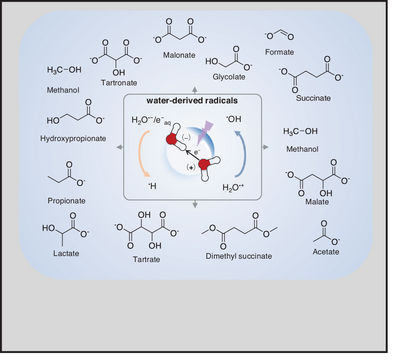Ionized Water Facilitates the Sustainable Radical-Mediated Reduction of CO2 to Multi-Carbon Hydrocarbons and Oxygenates
Graphical Abstract
Ultraviolet (UV) irradiation of water generates radicals (H2O•+, •OH, e⁻aq, •H) that reduce CO2 to C1─C6 hydrocarbons and oxygenates. e⁻aq activates CO2 into CO2•⁻, while •H enables hydrogenation. Oxidative radicals recycle oxygenates back into CO2•⁻, sustaining a sustainable network. This process demonstrates ionized water as a reactive matrix for abiotic organic synthesis.
Abstract
The abiotic synthesis of organic compounds from CO2 and water under prebiotic conditions is a fundamental yet unresolved challenge in understanding the origins of life. Here we demonstrate a radical-mediated pathway for reducing CO2 to C1‒C6 hydrocarbons and oxygenates driven solely by ultraviolet (UV) irradiation of water, mimicking early Earth environments. Using electron paramagnetic resonance (EPR), 17O/13C isotope labeling, and femtosecond transient absorption, we identify ionized water-derived radicals (H2O•+, •OH, e⁻aq, •H) as the key redox mediators. e⁻aq acts as a super-reductant (−2.9 V) to activate CO2 into CO2•⁻, while •H enables sequential hydrogenation. Critically, oxidative radicals (H2O•+ and •OH) recycle recalcitrant oxygenates (formate and oxalate) back into active CO2•⁻, sustaining a dynamic radical network. This process generates a diverse library of organic compounds, including methane, ethylene, and C6 dimethyl succinate, via radical assembly mechanisms spanning hydrogen-atom transfer (HAT), self-coupling, and cross-coupling. By integrating experimental validation with prebiotic simulations (formate-mediated redox modulation), we resolve the paradox of inert CO2/H2 activation in primordial environments and establish water not merely as a solvent but as a reactive matrix directing abiotic organic synthesis.
Conflict of Interests
The authors declare no conflict of interest.
Open Research
Data Availability Statement
The data that support the findings of this study are available in the Supporting Information of this article.





